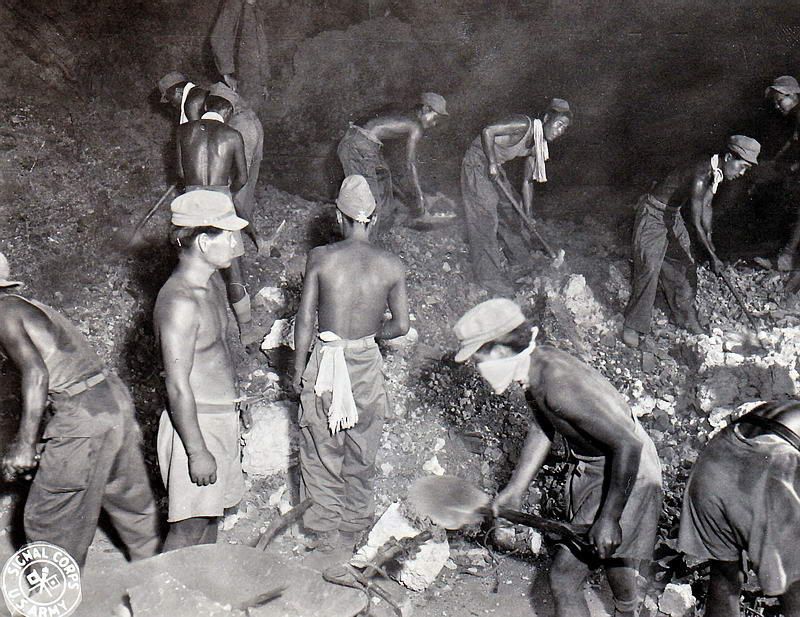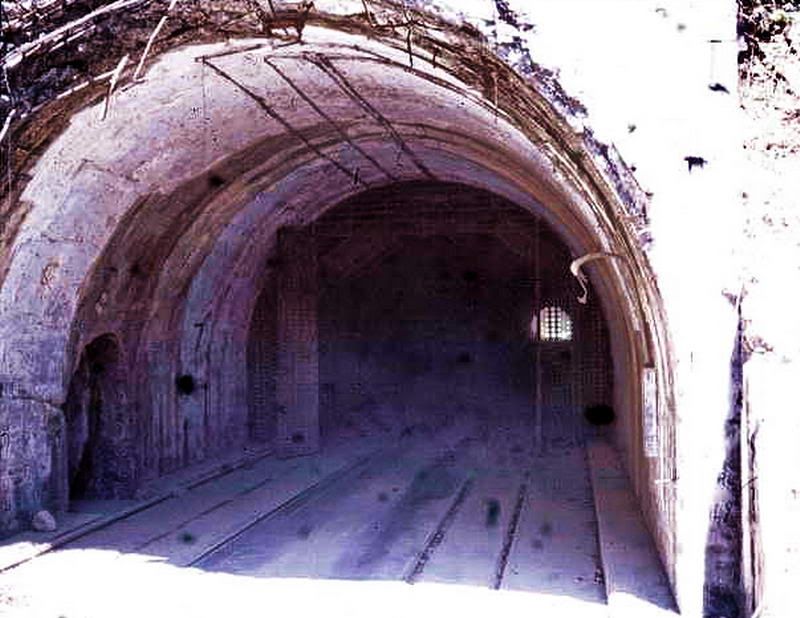|
|
Post by armyjunk on Jul 18, 2012 7:54:33 GMT 8
How about a June 17th 1937 official length of 831.6 ft long for the Main Passage, 24 ft wide a 18ft high in the center, A sidewalk on either side 1ft 9inches wide, with a roadbed of 20ft.6", and a double track 3 foot gauge with a 3foot clearance between the tracks.
1 CW storage 12x10x140
3 Gasoline storage 12x13x140
4 Ord Mags 12x12x162
6 Ord Mags 12x10x162
1 Ord Mags 12x12x112
6 Ord Mags 12x10x140
1 Ord Mag 12x12x120
1 latrine 10x8x15
|
|
|
|
Post by armyjunk on Jul 18, 2012 8:02:17 GMT 8
For the Main N-S Passage starting at Lateral No3 of the Main Tunnel we have a Main N-S length of 553' x 12'wide x 10'high, with
12 Storage chambers 10x8x162
2 vent Passages 4x6x200'
1 vent shaft 4x4x65' at 45 degrees
1 vent shaft 4x4x105' at 45 degrees
also dated 1937
|
|
|
|
Post by okla on Jul 18, 2012 9:44:08 GMT 8
Hey Army....I buy it all. I have never seen your "Nitty Gritty" to be in error as yet. Cheers.
|
|
|
|
Post by fots2 on Jul 18, 2012 12:54:30 GMT 8
Thanks armyjunk for the information. I have not seen these figures nor bothered to measure very much of it. The figures seem reasonable with a couple of exceptions. The angle of the Hospital air shafts seems low but it might be correct.
Two figures that are way off are the height and width of the Hospital vent passages. Since we seem to see these figures often I wonder if they originally were this size and at some later date the passages were enlarged. I have read that Malinta Tunnel construction work continued even after the war started, so much for the 1922 to 1932 construction dates that are often quoted.
|
|
|
|
Post by EXO on Jul 18, 2012 15:22:16 GMT 8
Those figures are interesting, but let me throw in two comments where there may be variations which make me "feel" that what I'm seeing today is actually fooling my sense of size. (a) When there is an explosion in a passage, the surrounding rock is fractured everywhere, but gravity then takes over and causes the roof to collapse, making the passage taller. And, after removing the rocks, unless you are going to clear the floor with a shovel, there will be a few inches of dirt, dust etc added to the height of the floor.
(b) The main shaft of Malinta that we see is not the original size shaft, as it is a reconstructed archway built postwar inside the tunnel, over the roadway, to protect us from rock falls. (I have no objection to this, a rock fall on your head can ruin your whole day.) So though I don't doubt an inch of armyjunk's figures, or of fots2's observations, I feel that any relationship between those figures and what we can measure today might be purely coincidental. The extent of variation between the two is fascinating. It's a shame that, before we came along, no one kept a history of what happened on the island throughout the post-war years. |
|
|
|
Post by pdh54 on Jul 18, 2012 16:13:27 GMT 8
For what it is worth, Amea Willoughby in her book I Was on Corregidor, p107, says "The tunnel was wide enough to accommodate four cars abreast when it was empty, but no one ever saw it that way."
|
|
|
|
Post by fots2 on Jul 18, 2012 20:14:33 GMT 8
As EXO says, the main Malinta Tunnel shaft was relined in the 70s or 80s so that is why it looks undamaged today. Since the bare rock shaft is quite a bit larger than the new concrete lining, I wonder if any thought went into rebuilding the lining to the same dimensions as the original one. It is probably close but I doubt that was much of a concern. I agree with his (a) and (b) comments. In the “scary” tunnels we were talking about earlier, the ceiling had collapsed due to explosions in 1945 and we were walking of tons of uneven broken rock high above the original tunnel floor. Here is a view not many people have seen. I took this photo looking at the rounded top of a concrete lined tunnel (seen left to right in the photo). A perpendicular lateral can be seen at mid bottom. Notice how much higher the actual rock shaft is for both the tunnel and the lateral.  Where was this photo taken? I am standing on broken concrete of a south side lateral looking at the lining of the main east-west Malinta Tunnel. |
|
|
|
Post by sherwino on Jul 18, 2012 21:35:11 GMT 8
Nice shot, Fots. Now, I have to re-imagine how really the tunnel looked like during the war. do you have an old picture of the bare main shaft?
|
|
|
|
Post by fots2 on Jul 18, 2012 22:11:37 GMT 8
Hi sherwino, I have a couple photos that you may be interested in. The first photo is labeled as Japanese POWs working in Malinta Tunnel. From the size of the shaft I assume this is the main east-west tunnel. The second photo from 1967 seems to show a big pile of rubble a ways inside the west entrance. It covers up the trolley line tracks. This was taken before the restoration work was started.   I wish I had more photos taken before the clean-up. |
|
|
|
Post by okla on Jul 18, 2012 22:32:12 GMT 8
Hey Fots....It is tough to realize that these pathetic looking little gentlemen, not too far in the past, were among some of the most fanatical, formidable, tenacious, disciplined, fighters that the United States military ever faced in mortal combat. In the pic they are nothing but docile, manual laborers. That old bolt action rifle with the elongated "pig sticker" bayonet certainly made them a different "breed of cat" didn't it???
|
|